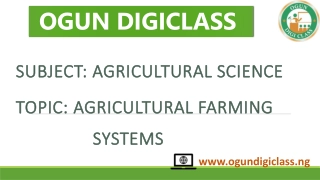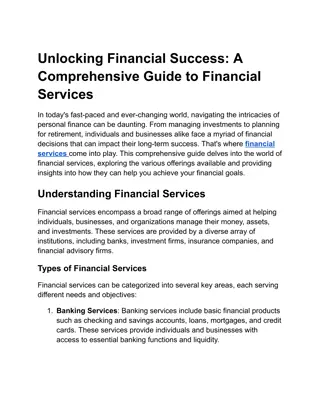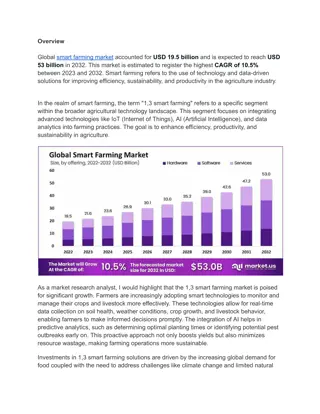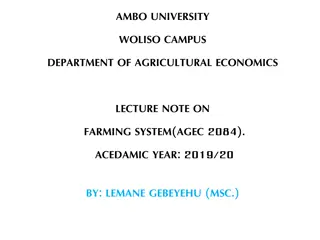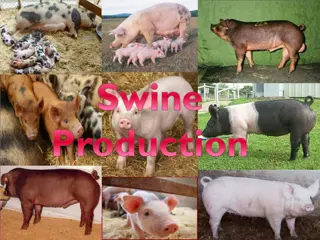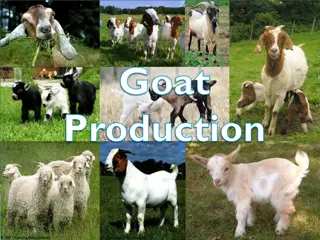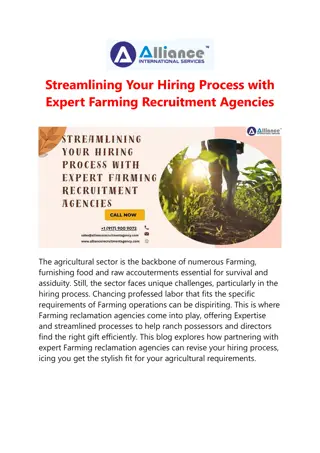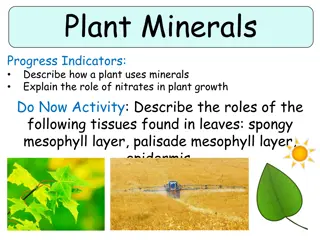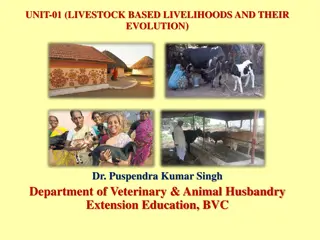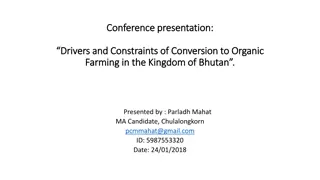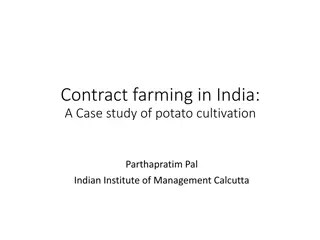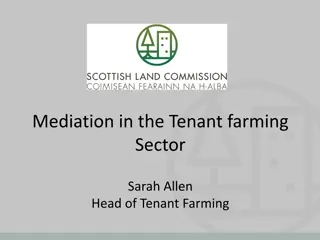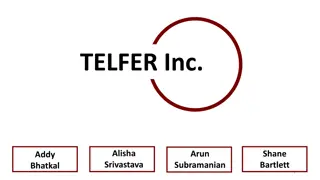The Changing Face of Farming: A Financial Perspective
This presentation highlights the financial aspects of farming, focusing on business operations, profitability, asset values, equity, debt trends, and the impact of land values on wealth accumulation. It also discusses the role of water access and nutrient limits in shaping land prices and the implications of legislation driven by the National Fresh Water Policy Framework. The data presented sheds light on the evolving landscape of farming practices and the key factors influencing farmers' financial decisions.
Download Presentation

Please find below an Image/Link to download the presentation.
The content on the website is provided AS IS for your information and personal use only. It may not be sold, licensed, or shared on other websites without obtaining consent from the author.If you encounter any issues during the download, it is possible that the publisher has removed the file from their server.
You are allowed to download the files provided on this website for personal or commercial use, subject to the condition that they are used lawfully. All files are the property of their respective owners.
The content on the website is provided AS IS for your information and personal use only. It may not be sold, licensed, or shared on other websites without obtaining consent from the author.
E N D
Presentation Transcript
The Changing Face of Farming Presented by: George Collier ICL Limited, Chartered Accountants www.iclca.co.nz
What Business Are Farmers In? Operating Business Grass Growing & Grass Harvesting Business Land Ownership Business Profitability Provides Choices Over Time Capital Growth
ROA & Increase In Land Value 30 25 20 Percent 15 Increase in Land value 10 Return on Farming Asset (Operating Business) 2014 Estimate 5 0 2001 2002 2003 2004 2005 2006 2007 2008 2009 2010 2011 2012 20132014 Estimate
Assets, Equity & Debt 2001-2014 Central Otago Farming Business Balance Sheet $1,000 $900 $800 $700 $600 $ / Su $500 $400 $300 $200 $100 $0 Equity Debt
Average Central Otago Farming Business Last 13 Years (2001 2014) $ Annual % Annual Compound 8,000 stock units Assets $280 to $1000/su +260% + $5.76m + 12% + 9% Debt $80 to $160/su +100% + $0.64m + 8% + 6% Equity $200 to $720/su +260% + $5.12m + 12% + 9%
Land Values Providing 85% of Increase in Wealth Over Time Land Value Drivers Returns Access to Debt/Capital Cost of Debt/Capital Access to Water Access to Reliable Water Ability for Land Use Charge Nutrient Limits Old New Land Value Driver Shift from land reliable water nutrient caps. Access to reliable water is now driving land value. Nutrient Caps will limit land value in future.
Value of Water & Its Impact On Land Price Irrigation Equity Potential Dryland Equity Potential (Access to Water) 2011 2012 2013 2014 2015 Dryland Irrigable Dryland Irrigated Unreliable Irrigated Nutrient Cap
What Are The Implications of Legislation Driven From the National Fresh Water Policy Framework Regional Council Outcomes: - 30 kg Nitrate leachate/hectare Nutrient Limits - Plan Change 6A (2020) May limit some land use intensification Efficiency Use of Water - Plan Change 1C (2021) May affect some irrigation applications methods in some locations
Irrigation Efficiency (The Amount of Water Applied That Stays In The Soil) Centre Pivot 90% Roto-Rainer 80% Big Gun 75% K-Line 70% Border Dyke 55% Winter Flood 45% Increased efficiency leads to more intensive farming systems Increased production is essential Differences within the catchment depending on the ability to reuse the water
Irrigation Systems Pivot Gun K-Line Border Dyke Wild Flood Irrigation Dryland 0 2,000 4,000 6,000 8,000 10,000 12,000 14,000 Pasture Yield (kg DM/ha)
Technology Driving Productivity Crop Yield Cost/ha Cost/kg DM Return c/kg DM Net Return c/kg DM Net Surplus Crop Yields 25,000 F-Beet 2500 10c 27c 17c 4,250 Pivot 15,000 Kale 1500 9c 27c 18c 2,880 Gun 12,000 Kale 1,300 10c 27c 17c 2,040 K-Line 11,000 Kale 1,200 11c 27c 16c 1,700 Border Dyke 9,000 Kale 1,000 10c 27c 17c 1,530 Wild Flood Irrigation 8,000 Kale 1,000 10c 27c 17c 1,360 Dryland 5,000 Kale 800 16c 27c 11c 700
Conclusion 1. Every Farming Business Has To Work Out A Strategy Vision for Family & The Business Strategy Growth Scale - /Diversity of land Use Profitability Enable Family & Farm Succession Staying the Same - but legislation is driving change Selling - repurchasing elsewhere - exit Retaining a passive investment J.V. Model 2. Land price will be influenced by access to reliable water & nutrient limitations 3. Technology will continue to drive productivity 4. We need to target high paying markets



